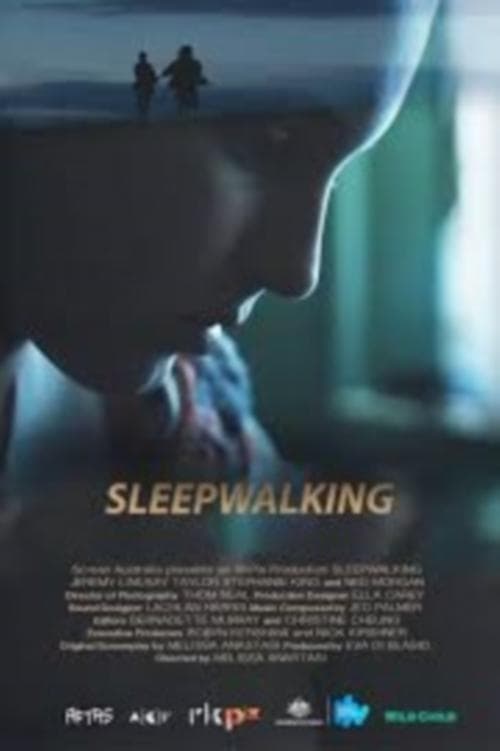
Ask Your Own Question
What is the plot?
The story of Sleepwalking (2018), directed by Melissa Anastasi, unfolds on a remote, isolated property where a teenage boy, Tommy, lives with his mother, Claire, and his fanatical stepfather, Hank. The exact date is unspecified, but the setting is a rural, sun-drenched homestead surrounded by vast, empty fields, evoking a sense of isolation and entrapment. From the opening moments, the tension is palpable: Tommy navigates the oppressive atmosphere created by Hank's rigid, almost cult-like control over the household.
Tommy is introduced quietly, a boy on the cusp of manhood, caught between childhood innocence and the harsh realities imposed by Hank. His mother, Claire, is weary and subdued, her spirit dimmed by years of subjugation under Hank's fanatical rule. Hank himself is imposing and authoritarian, his presence dominating the house with an unsettling intensity. There is no warmth in his gaze, only a cold fanaticism that permeates every corner of the property.
The film opens with Tommy observing his stepfather's strict routines and harsh discipline. Hank's fanaticism is evident in his rigid adherence to rules and his distrust of the outside world. The family rarely ventures beyond the property's boundaries, which are marked by barbed wire and dense woods, symbolizing their captivity. Tommy's eyes often drift toward the horizon, yearning for freedom, while Claire's face reveals a quiet desperation.
One evening, the tension breaks when Tommy overhears a heated argument between Claire and Hank. Claire pleads, "We can't live like this anymore, Hank. It's killing us." Hank's response is cold and unyielding: "You belong here. This is your life now." Tommy's heart pounds as he realizes the depth of his stepfather's control and the danger it poses to his mother.
Determined to protect Claire, Tommy begins to secretly plan their escape. He discovers a hidden key to the gate, tucked away in Hank's cluttered workshop--a symbolic object representing their chance at freedom. Tommy and Claire communicate in hushed whispers and coded glances, their bond strengthening as they share the perilous hope of escape.
The night of their planned escape is thick with tension. As the moon casts long shadows over the property, Tommy and Claire move stealthily through the house, avoiding creaking floorboards and the sharp eyes of Hank. Just as they reach the gate, Hank appears, blocking their path with a menacing glare. "Where do you think you're going?" he demands, his voice low and dangerous.
Tommy stands firm, his voice trembling but resolute: "We're leaving. You can't keep us here anymore." A fierce confrontation ensues. Hank lunges at Tommy, but Claire intervenes, pushing Hank back and shouting, "Let him go, Hank! This ends now!" The struggle is chaotic and brutal, the tension peaking as the family's fractured bonds snap.
In the struggle, Hank grabs a heavy metal rod from the ground, swinging it wildly. Tommy dodges, but Claire is struck, collapsing with a cry of pain. The sight of his mother hurt ignites a fierce protective rage in Tommy. He wrestles the rod from Hank and, in a desperate act of self-defense, strikes Hank with it. Hank falls to the ground, motionless.
Tommy and Claire, shaken but alive, seize the moment to flee through the gate into the dark woods beyond. The camera lingers on Hank's still form, the fanatic's reign ended by the very family he sought to control.
As dawn breaks, Tommy and Claire reach the edge of the woods and see the distant lights of a small town--the outside world, once a distant dream, now within reach. Claire, clutching Tommy's hand, whispers, "We're free." Tommy looks back once, his eyes filled with a mixture of relief and sorrow, before turning toward the future.
The film closes with the pair walking hand in hand toward the town, their silhouettes bathed in the soft morning light--a poignant image of survival, resilience, and the enduring bond between mother and son.
Throughout Sleepwalking, every confrontation, every whispered plan, and every desperate act of courage builds toward this climax, revealing the devastating impact of fanaticism on family and the indomitable human spirit's quest for freedom. The deaths and violence are not gratuitous but emerge organically from the characters' struggle, underscoring the high stakes of their escape and the cost of breaking free.
In the end, Tommy and Claire survive, their escape marking both an end and a beginning. Hank's death is the final, tragic consequence of his fanaticism and cruelty. The narrative leaves viewers with a powerful meditation on loyalty, protection, and the painful but necessary journey toward liberation.
What is the ending?
In the ending of "Sleepwalking," the main character, a young woman named Jodie, confronts her past and the choices she has made. After a series of emotional revelations and confrontations, she ultimately decides to take control of her life, leading to a moment of self-acceptance and a new beginning. The film concludes with Jodie stepping into a new chapter, leaving behind the burdens of her past.
As the film approaches its conclusion, we find Jodie in a state of turmoil, grappling with the weight of her decisions and the impact they have had on her life and those around her. The atmosphere is heavy with tension as she navigates her relationships, particularly with her estranged mother and her own sense of identity.
Scene by scene, the ending unfolds as follows:
The first scene shows Jodie sitting alone in her dimly lit apartment, the remnants of her past scattered around her. She stares blankly at the walls, reflecting on the choices that have led her to this moment. The camera captures the shadows that dance across her face, symbolizing the internal conflict she faces. Her phone buzzes, breaking the silence, and it's a message from her mother, urging her to come home. Jodie hesitates, her fingers hovering over the screen, torn between the desire for reconciliation and the fear of facing her past.
In the next scene, Jodie finally decides to visit her mother. The drive is filled with a mix of anxiety and determination. The landscape outside the car window shifts from urban chaos to the quiet of the countryside, mirroring her internal journey from chaos to a search for peace. As she arrives at her childhood home, the camera lingers on her hesitant footsteps as she approaches the door, each step heavy with the weight of unresolved emotions.
Inside, the atmosphere is thick with unspoken words. Jodie and her mother exchange awkward pleasantries, but the tension is palpable. They sit across from each other at the kitchen table, the silence stretching uncomfortably. Jodie's mother, visibly aged and weary, looks at her daughter with a mix of hope and fear. Jodie's internal struggle is evident as she battles with her feelings of resentment and longing for connection.
As the conversation unfolds, Jodie finally opens up about her feelings of abandonment and hurt. Her voice trembles as she recounts the pain of growing up without her mother's support. The camera captures the raw emotion in her eyes, revealing the vulnerability she has kept hidden for so long. Her mother, in turn, shares her own regrets and the reasons behind her choices, creating a moment of mutual understanding. The scene is charged with emotion, as both women confront their pasts and the impact of their decisions on each other.
In the climax of the film, Jodie makes a pivotal decision. She stands up from the table, her expression resolute. She tells her mother that she needs to take control of her life, to stop being defined by their shared history. This moment is visually striking, as the camera focuses on Jodie's determined face, symbolizing her newfound strength. She walks out of the house, leaving her mother behind, but not without a sense of closure.
The final scene shows Jodie standing on a hill overlooking the horizon, the sun setting in the background. The colors of the sky reflect her emotional transformation--warm hues of orange and pink signaling hope and renewal. She takes a deep breath, feeling the weight of her past lift as she embraces the possibility of a new beginning. The film ends with Jodie walking forward, her silhouette framed against the vibrant sky, symbolizing her journey toward self-acceptance and the promise of a brighter future.
In this ending, Jodie's fate is one of empowerment and growth. She has faced her demons and chosen to move forward, leaving behind the burdens that once held her captive. Her mother, while still grappling with her own regrets, is left with a sense of hope for their relationship. The film closes on a note of resilience, emphasizing the importance of confronting one's past to pave the way for a better future.
Is there a post-credit scene?
In the movie "Sleepwalking" produced in 2018, there is no post-credit scene. The film concludes its narrative without any additional scenes or content after the credits roll. The story wraps up with a focus on the emotional and psychological journey of the characters, leaving the audience to reflect on the themes presented throughout the film.
What motivates the main character, Jodie, to leave her life behind and go on the run?
Jodie, portrayed as a deeply troubled individual, is driven by a desperate need to escape her past and the overwhelming guilt she feels for her actions. Her internal conflict is exacerbated by her strained relationship with her mother and the haunting memories of her childhood, which compel her to seek a fresh start, even if it means abandoning her responsibilities.
How does Jodie's relationship with her daughter, Emma, evolve throughout the film?
Initially, Jodie struggles to connect with Emma, feeling unworthy of motherhood due to her tumultuous past. As the story progresses, their bond deepens through shared experiences and the challenges they face together. Jodie's protective instincts emerge, showcasing her growth as a mother, while Emma's innocence and resilience inspire Jodie to confront her demons.
What role does the setting play in Jodie's journey and emotional state?
The film's various settings, from the stark, desolate landscapes to the cramped, chaotic environments, mirror Jodie's internal turmoil. Each location she visits serves as a backdrop for her emotional struggles, reflecting her feelings of isolation and desperation. The contrast between the serene moments and the chaotic ones emphasizes her ongoing battle with her past.
How does the character of Jodie's mother influence her decisions throughout the film?
Jodie's mother represents a source of both pain and motivation for Jodie. Their fraught relationship is marked by unresolved issues and emotional scars, which haunt Jodie as she navigates her journey. The fear of repeating her mother's mistakes drives Jodie to make choices that ultimately lead her to seek redemption and a better life for Emma.
What are the key events that lead to Jodie's realization of her need for change?
Key events include Jodie's encounters with her past, such as unexpected reunions and moments of confrontation that force her to face her guilt. A pivotal moment occurs when she witnesses the impact of her choices on Emma, igniting a fierce determination to break the cycle of dysfunction. These realizations culminate in her decision to take control of her life and seek a path toward healing.
Is this family friendly?
"Sleepwalking," produced in 2018, is not considered family-friendly due to its exploration of complex and mature themes. The film delves into emotional struggles, family dynamics, and personal trauma, which may be challenging for children or sensitive viewers.
Potentially objectionable or upsetting aspects include:
- Emotional Turmoil: Characters experience significant emotional distress, which may be intense and difficult to watch.
- Family Conflict: There are scenes depicting strained family relationships and arguments that could be upsetting.
- Themes of Loss: The film addresses themes of loss and grief, which may resonate deeply and evoke strong emotions.
- Mental Health Issues: The portrayal of mental health struggles may be distressing for some viewers.
- Substance Use: There are references to substance use that could be inappropriate for younger audiences.
These elements contribute to a narrative that is more suitable for mature audiences rather than children.













